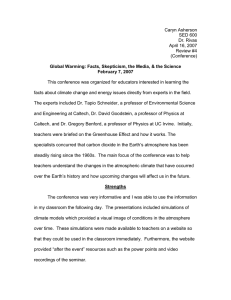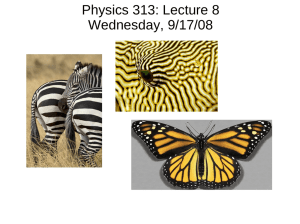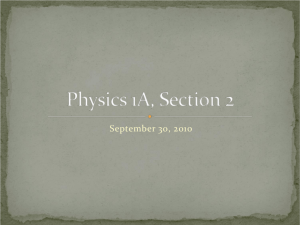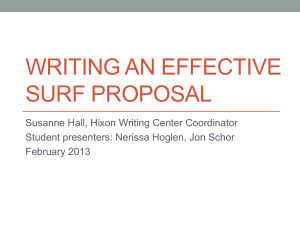Interview with Frank Press
advertisement
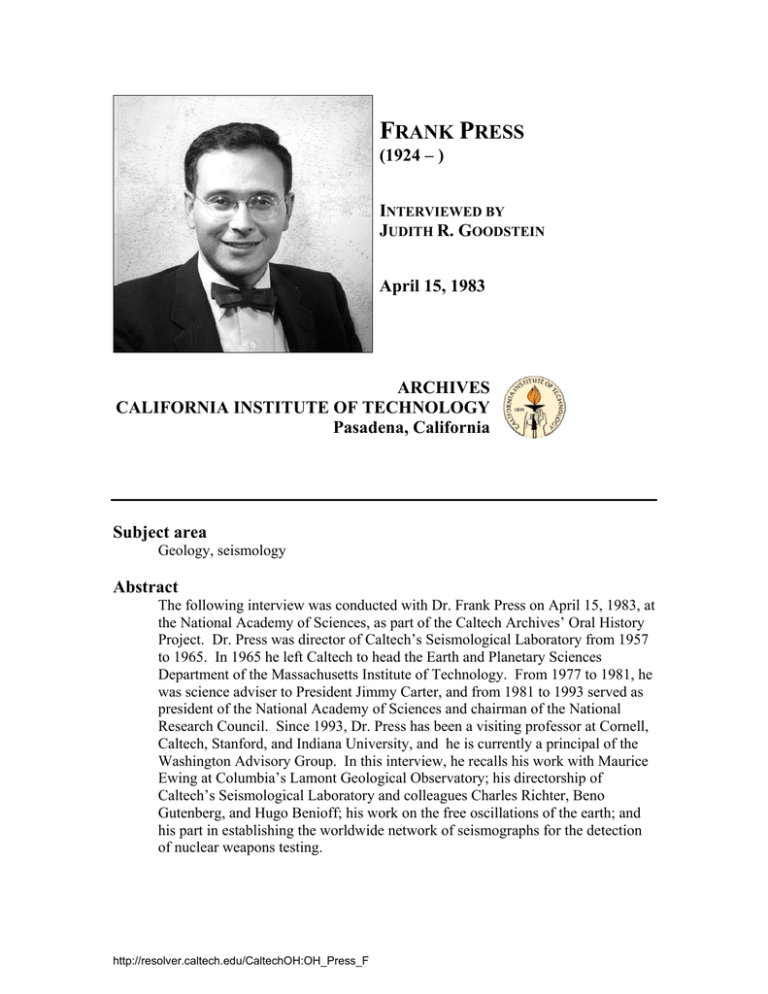
FRANK PRESS (1924 – ) INTERVIEWED BY JUDITH R. GOODSTEIN April 15, 1983 ARCHIVES CALIFORNIA INSTITUTE OF TECHNOLOGY Pasadena, California Subject area Geology, seismology Abstract The following interview was conducted with Dr. Frank Press on April 15, 1983, at the National Academy of Sciences, as part of the Caltech Archives’ Oral History Project. Dr. Press was director of Caltech’s Seismological Laboratory from 1957 to 1965. In 1965 he left Caltech to head the Earth and Planetary Sciences Department of the Massachusetts Institute of Technology. From 1977 to 1981, he was science adviser to President Jimmy Carter, and from 1981 to 1993 served as president of the National Academy of Sciences and chairman of the National Research Council. Since 1993, Dr. Press has been a visiting professor at Cornell, Caltech, Stanford, and Indiana University, and he is currently a principal of the Washington Advisory Group. In this interview, he recalls his work with Maurice Ewing at Columbia’s Lamont Geological Observatory; his directorship of Caltech’s Seismological Laboratory and colleagues Charles Richter, Beno Gutenberg, and Hugo Benioff; his work on the free oscillations of the earth; and his part in establishing the worldwide network of seismographs for the detection of nuclear weapons testing. http://resolver.caltech.edu/CaltechOH:OH_Press_F Administrative information Access The interview is unrestricted. Copyright Copyright has been assigned to the California Institute of Technology © 1983; revised version copyright Birkhäuser Verlag © 2004. Used by permission. Preferred citation Press, Frank. Interview by Judith R. Goodstein. Pasadena, California, April 15, 1983. Oral History Project, California Institute of Technology Archives. Created from revised version published in Physics in Perspective, 6 (2004), 184-196. Retrieved [supply date of retrieval] from the World Wide Web: http://resolver.caltech.edu/CaltechOH:OH_Press_F Contact information Archives, California Institute of Technology Mail Code 015A-74 Pasadena, CA 91125 Phone: (626)395-2704 Fax: (626) 793-8756 Email: archives@caltech.edu Graphics and content © 2004 California Institute of Technology. http://resolver.caltech.edu/CaltechOH:OH_Press_F CALIFORNIA INSTITUTE OF TECHNOLOGY ORAL HISTORY PROJECT INTERVIEW WITH FRANK PRESS BY JUDITH R. GOODSTEIN WASHINGTON, DC Caltech Archives, 1983 Copyright © 1983, 2004 by the California Institute of Technology http://resolver.caltech.edu/CaltechOH:OH_Press_F CALIFORNIA INSTITUTE OF TECHNOLOGY ORAL HISTORY PROJECT Interview with Frank Press by Judith R. Goodstein Washington, D.C. Session 1 April 15, 1983 Begin Tape 1, Side 1 GOODSTEIN: I’d like to begin with your assessment of Charles Richter and Beno Gutenberg. They didn’t have many students, did they? If you were to assess their importance today, it would probably be through the books they wrote. What do you think? PRESS: Well, Gutenberg and Richter were very great men. In 1955, when I came to Pasadena, it was the world center for seismology, for a number of reasons: the identification of the classical seismic phases by Gutenberg; the concept of a centrally organized network of stations; the quantitative measure of the size of an earthquake by the Richter scale, as modified by Gutenberg—and every major earthquake was given a value by them. Then there was the concept of seismicity of the earth in a quantitative way—magnitudes as well as distributions; statistics, continent by continent; and magnitude-energy-frequency relationships. An extraordinary array of things came out, and came out primarily in their books and papers. And the instruments, of course, were the Cadillacs of the field. GOODSTEIN: Why did you come? PRESS: Why did I come? Well, when the world’s greatest laboratory makes you an offer, you take it seriously. Secondly, Maurice Ewing, whom I had studied with and on whose staff I worked at the Lamont Geological Observatory, was a giant, and I wanted to diversify into other fields. And I also felt that for my own personal growth I had to set out on my own. http://resolver.caltech.edu/CaltechOH:OH_Press_F Press-2 Fig. 1. Maurice Ewing (left) and Frank Press at the Lamont Geological Observatory, spring 1950, shortly after Ewing’s research group moved from Columbia University’s Manhattan campus to Palisades, New York. Courtesy of the Columbia University Archives-Columbiana Library. GOODSTEIN: Were you wooed by the seismologists or by the geologists? PRESS: Caltech’s Geology Division at that time had a very powerful chairman, Bob Sharp. He was the principal negotiator, but I’m sure he wouldn’t have brought me in without the support of Gutenberg, Richter, and Hugo Benioff, the three seismologists there. With respect to students, you’re quite right. All three had graduate students; but there were only a few and they made their mark primarily in industry, where you don’t get known; you get forgotten in terms of the scientific field. So by and large, the Seismological Laboratory’s reputation stemmed from the research of the three principals. Incidentally, it has to be said that the excellent way in which Caltech supported that laboratory with its own money—this was before the days of big government contracts—and supported the technical assistants and http://resolver.caltech.edu/CaltechOH:OH_Press_F Press-3 engineers behind these men, was an extraordinary thing. At Lamont, it was all hustling for government money. But at that time, Caltech had a basic core support that it could depend on, so that there wasn’t a single government dollar coming in that would affect their standards. Fig. 2. The stars of the Seismological Laboratory, 1956. Left to right: Frank Press, Beno Gutenberg, Hugo Benioff, Charles Richter. Source: Los Angeles Examiner When I became director, I leveraged the Caltech money by adding some additional money, because we were getting into the computer age. When the first computers started to come in, we tried to digitalize the seismological equipment. Graduate students in larger numbers are costly; they are supported on government contracts. Postdocs are needed to build a modern research team; you want to bring in people with different backgrounds and different skills. The Caltech funds supported the laboratory’s basic operations—the instruments, the technical backup—and I built on top of that with Sharp’s support; we made a very powerful combination. http://resolver.caltech.edu/CaltechOH:OH_Press_F Press-4 The formula worked, because today if you look at the budget of that laboratory there must be many millions of dollars, and the Caltech core support is probably less now than in the past. GOODSTEIN: When you came, did you notice any friction between Gutenberg and Richter? Did they quarrel a lot? PRESS: It was a love-hate relationship. They didn’t like each other but they respected each other. There was competition. These were two strong personalities, each trying to do good work and receive recognition for it. And they were in overlapping fields—for example, the magnitude scale. So it was an uneasy truce, but they let each other live. Once in a while there was a flairup. GOODSTEIN: But most of Richter’s publications are coauthored with Gutenberg? PRESS: That’s right. It was a marriage of convenience. Everybody recognized it as that, but we didn’t think it was an extraordinary thing. The lab was a very nice place. There wasn’t any tension there. They were two giants who occasionally saw things differently—in the style of operation of the place or how a piece of data might be interpreted. And then they came from two entirely different cultural backgrounds. In many places where you have these kinds of people— very strong, very confident people—the atmosphere is frenetic and tense and unpleasant. That wasn’t the case. But there was a rivalry, a lack of friendliness, nevertheless. GOODSTEIN: The research I’ve done indicates that the scale developed and applied to Southern California earthquakes was Richter’s doing, and its extension to earthquakes worldwide was a combination, and perhaps more Gutenberg than Richter. PRESS: Your perception is correct. The original concept of the logarithmic scale was Richter’s, but the important thing is worldwide magnitudes and that’s what Gutenberg contributed, mostly—although Richter helped out as well. How you assign credit to something like the Richter scale is very difficult, on ethical grounds or whatever. It’s a difficult question of relations between people. And then on top of that, the media always like a shortcut: they like http://resolver.caltech.edu/CaltechOH:OH_Press_F Press-5 one name; they don’t want something called the Richter-Gutenberg or the Gutenberg-Richter scale. They want a single name, like the Salk vaccine. The Nobel Prize for the work that resulted in the Salk vaccine was won by somebody else: it was won by John Enders, Tom Weller, and Fred Robbins. Without their work, which the scientific community recognizes, Salk couldn’t have followed up. In other words, in the history of science you have to think about why a certain idea happened at a certain time—how Richter had the idea, why he didn’t extend it, and why Gutenberg could. Richter was more concerned with California because he knew California geology—he hiked all over California, he grew up there, he knew the important California faults, he knew the dangers of an earthquake in California. Everybody came to Richter, asked his advice—he was California-oriented. Gutenberg, coming from Europe, had a world view; he was more concerned with the physics of the earth, the deep interior of the earth, than with the statistics of local earthquakes. That’s the difference between the two, and that accounts for their different research interests and styles. GOODSTEIN: In 1957, when you took over as director of the lab, did you have any conflicts with staff people? Was it a smooth transition from Gutenberg to you? PRESS: I think so. Though I think Hugo Benioff must have been disappointed that he wasn’t named director. GOODSTEIN: Would Richter have been interested in that position? PRESS: Richter never expected it. He was more interested in detail; he never thought of himself as a good administrator. I think he was pleased that I was named director. GOODSTEIN: When you came to Caltech in 1955, did you understand then that you might be looked over as the successor to Gutenberg? http://resolver.caltech.edu/CaltechOH:OH_Press_F Press-6 Fig. 3. Beno Gutenberg at work, 1958. German-born and Göttingen-trained, Gutenberg brought to Caltech the European tradition of viewing seismology as a research tool. He also played a major role in extending Richter’s instrumental magnitude scale to earthquakes anywhere. Caltech Archives. PRESS: As director? Not really, because Benioff was something like twenty-five years older than I was. I forget what the age difference was, but it was a huge one. No, I was more interested in building my scientific reputation than in running a laboratory, and I wouldn’t have minded in the slightest if he’d been named director; in that case, I would have had my turn ten years later when he reached his retirement age. It would have worked out very well. I had all the support I needed—it would have been fine for me. GOODSTEIN: Do you know who proposed you as director? PRESS: It would have been an issue between Sharp and Gutenberg. http://resolver.caltech.edu/CaltechOH:OH_Press_F Press-7 GOODSTEIN: Did you make any significant changes when you became director in 1957? PRESS: Now, don’t think that when I took over, I had an agenda. It was a very smooth transition. The changes were more in the direction of where geophysics was moving—after all, I was a member of the next generation after these people. The science moved ahead, and I just simply—using the resources of the lab and also the resources that I developed in the government—brought in new people and new technology. This meant computers; this meant new types of seismographs; this meant more field exploration. My attitude toward graduate students was different, I must say. I used graduate students as colleagues: I gave them the best problems to work on, and I encouraged them. GOODSTEIN: So there was a big difference in the way you treated them, as opposed to the way Gutenberg, Richter, and Benioff treated their students? PRESS: I would say yes. But it might have been a sign of the times and not just a matter of personalities. The notion of graduate students as colleagues rather than students is a more modern notion, I think—across the country, in many different fields. GOODSTEIN: How would you describe your own experience as a graduate student with Maurice Ewing, at the Lamont Observatory? PRESS: The same; he treated me as a colleague from the very beginning. He was a very powerful director, and everything went his way, but from the outset I felt that I was more a scientist than a student. And he encouraged that. As a graduate student, I was in charge of my own contracts and grants—I was essentially responsible for doing the research and managing them. But that wasn’t only Ewing: it was happening in physics, chemistry—it was part of the explosion of science in this country. And to this day I would bet that half of the papers published at Caltech are written by graduate students. That’s a change from forty years ago. We used to say about Gutenberg that he saved the best problems for himself and not his students. I http://resolver.caltech.edu/CaltechOH:OH_Press_F Press-8 don’t take that as a criticism of Gutenberg—that was the style of the time and he was a product of his time. GOODSTEIN: Did he aggressively recruit graduate students? PRESS: No, they applied. GOODSTEIN: You changed that, too? PRESS: Oh, yes. GOODSTEIN: How do you go out and recruit graduate students if that’s never been done before? PRESS: Oh, there’s no one way. You travel across the country, you visit departments, you give talks, you talk about the work at your laboratory—what’s going on, what the opportunities are there—you talk about your own research. You go to meetings. You meet faculty; you ask, “Do you have any good students for me?” And then when the applications come in, if you see somebody who’s very bright, you work hard to get him. And then gradually, it gets to be a selfsustaining process. Very few people have turned out as many graduate students as I have. GOODSTEIN: Do you have any idea how many PhD’s you turned out in the ten years you were at Caltech? PRESS: No, but it’s a lot. The quickest way to find out is to go down the list of my publications, because they were all coauthors of papers with me. GOODSTEIN: Did you turn out just as many when you went on to MIT in 1965? PRESS: About half as many, because I went there as chairman of the department [of Earth and Planetary Sciences]. http://resolver.caltech.edu/CaltechOH:OH_Press_F Press-9 GOODSTEIN: When you look back now, what do you see as the most important scientific work you did at Caltech in those ten years? PRESS: I’ll tell you all the things that I think are important, but I won’t prioritize: I did the new approach to surface waves; the work on shallow and deep crustal structure, using surface waves and field studies; the study of the asthenosphere; and I pioneered the use of very long waves, opening up a whole new field; Caltech’s first digital seismograph. GOODSTEIN: When did the first digital seismographs come in? PRESS: I’d say in the late fifties. I’m not claiming to have had the first digital seismographs. I’m saying we were there when there weren’t very many around. GOODSTEIN: Did the introduction of that kind of technology lead to the discovery of the free oscillations of the earth by earthquakes? Does such a discovery, in other words, depend upon the technology being in place first? Fig. 4 Frank Press, professor of geophysics and director of Caltech’s Seismological Laboratory, displays one of the first seismograms of the great Alaska earthquake on March 27, 1964. Caltech Archives. PRESS: Depends on the technology and the pre-existing theory. GOODSTEIN: In your case, how did the discovery come about? PRESS: I would say it came about this way. There were two seismographs at Caltech. One was the Press-Ewing, the other was the Benioff. Now, this is a very controversial field; everybody will give you a different view. I’ll just give you mine. http://resolver.caltech.edu/CaltechOH:OH_Press_F Press-10 GOODSTEIN: Before we get into that, did you bring the Press-Ewing instrument with you to Caltech? PRESS: The Press-Ewing instrument had been developed at Lamont. Ewing did more for his students than most people, but it was also automatic that he coauthored papers as well. And he should have, because although the students carried the research load and drafted the paper, Ewing would improve the second draft significantly. So I think he earned his coauthorship. But essentially, the Press-Ewing seismograph was my work, with his encouragement and improvement—and he deserves credit for that. So, yes, I brought that instrument and the knowledge of how to interpret the new data to Caltech, and I improved it even further. With Caltech’s superb engineering staff, it was very easy to try out a lot of things. On the free oscillations of the earth, my view of the history is the following: The theory was around for a long time; it goes back to the nineteenth century. And so everybody had it in mind to try to observe it. The first effort—the first claim that it might have been found—came about as follows: There was a big earthquake—I think it was Kamchatka, in 1952—and these long waves had been recorded on the Press-Ewing seismograph. Dave Harkrider and I were looking at that, and we said, “Maybe it’s there.” So I said, “Dave, you digitize this thing by hand.” It was laborious work; he almost went blind. And there was our brand new computer for doing Fourier analysis, so we Fourier-analyzed the hand-digitized seismogram and discovered all of these peaks. Because of the crudeness of the process, the peaks at the long end were noise, but at the short end they were really higher-mode free oscillations of the earth, and we published an abstract claiming that they were the higher modes. Everybody forgot about that—or maybe not, I don’t know. But then came another earthquake—in Chile, May 1960—for which the Benioff instrument had the best record. Other people, by that time, had good instruments as well, and everybody had the same goal in mind. But we had all of the programs for efficient Fourier analysis, because of the preceding work. Stewart Smith was now involved; the data was digitized; and the fundamental mode was discovered almost simultaneously at Caltech, UCLA, and a few weeks later at Lamont. GOODSTEIN: How long did it take you from the time you saw that you had good records on the Benioff to knowing what you had? http://resolver.caltech.edu/CaltechOH:OH_Press_F Press-11 PRESS: It was pretty fast. This is an interesting story; I haven’t thought about it for a long time. Benioff was very excited, and he proposed that he and Stewart Smith had discovered it. He also proposed to write a paper by himself. And I thought that was unfair to the group. Benioff didn’t know any theory, and he didn’t have the computer programs. I had brought the computer in, arranged for the programs, and tried them with Harkrider and Smith. It was a natural extension of the earlier work, since anybody could have done it once those procedures were established. So I think I convinced Benioff that it should be a three-way paper.1 That’s my recollection of the history. GOODSTEIN: Was there any sense of beating out the other institutions? PRESS: Oh, very much, yes. The competition was very keen. This kind of thing happens over and over again in science. As soon as one person finds something important, many people also discover it, knowing that it’s possible to do so. GOODSTEIN: What instruments did they have at UCLA? PRESS: They had a different kind of instrument—a gravimeter. GOODSTEIN: Then the three laboratories had good seismic records? PRESS: All three places had them good enough. There might have been some exchange of records back and forth after a while, after the initial discovery. Sometimes another lab will have a new idea for analysis, a better way to pull information out of data. The UCLA instruments were deficient in that they didn’t record horizontal motion, and that was very important. So they may have borrowed our data to supplement their own. I think that when Lamont learned about the initial discoveries, then they started to analyze their own records. And they requested that the Journal of Geophysical Research hold up publication until they got their paper in.2 You know, it’s that kind of business. http://resolver.caltech.edu/CaltechOH:OH_Press_F Press-12 GOODSTEIN: Did all three papers come out simultaneously? PRESS: Yes, they did, in 1961. GOODSTEIN: But your earlier work hadn’t been noticed? PRESS: The earlier work was an oral paper; we made the claim in an abstract for the program of a scientific meeting.3 In that abstract, the actual periods are given; the first few were wrong, because they were not significantly different from the noise. But the later spectral peaks agree with what we published later. GOODSTEIN: Did the audience sit up and take notice? PRESS: I think they did. I think it sensitized everybody. But we claimed that “we think we have”—we had no way of being sure. And there is one other point I should make. A very important paper by [Chaim] Pekeris came out, which showed how to calculate these spectral peaks of free oscillations for a real earth.4 So the important thing was that Pekeris’s predictions were exactly what was observed in the Caltech, UCLA, and Lamont papers. But there was no way that Harkrider and I could have validated our observations. There was no way of saying— because we couldn’t calculate them theoretically until Pekeris did his work—that our observations matched the theoretical predictions for a real earth. They were, you know, roughly correct, but we weren’t sure, because we didn’t know how to calculate what they should be. That was why the abstract didn’t receive as much notice as the later work, in which observation and theory were shown to be in near perfect agreement. GOODSTEIN: While you were at Caltech, you also became involved in using seismic equipment to detect nuclear explosions. How did this come about? PRESS: The government knew that the earliest nuclear explosions would be recorded on our instruments. So they came to us, borrowing records, looking at them, and gradually that became a contractual relationship. Actually, Gutenberg was in on it, and Richter as well, before I came. http://resolver.caltech.edu/CaltechOH:OH_Press_F Press-13 They were investigating nuclear explosions for scientific reasons—measuring their size and the travel time of the seismic waves. They may have had some contracts.5 GOODSTEIN: When you received the [Arthur] Day Medal, you said that your proposal to improve the worldwide network of seismic stations in connection with the 1963 Nuclear Test Ban Treaty might well be your most important contribution to science. PRESS: Perhaps so, but I don’t think so, on later reflection. I think the influx of money due to nuclear-test detection enabled the whole field to blossom. And the fact that I was one of those who designed this world network—I’m not the only one, [UCLA geophysicist] Dave Griggs was a very important player in this—gives me the sense of having achieved something important. But I think anybody who advised the government and who knew geophysics would have known that such a network was the obvious next step. I can’t claim special credit for that. It just happened because the opportunity was there, and Griggs and I seized it. GOODSTEIN: What was the atmosphere like at Caltech in the ten years you were there? Was it an exciting place to be? PRESS: Absolutely. The best geology department in the country, with an excellent chairman— and how Bob Sharp recruited, and his taste for excellence, is an extraordinary story in itself. He invested in young people; he didn’t follow the usual procedure for that time, which was to hire famous people. He went after young people, and he picked so well that they all became famous—most of them members of the National Academy. It’s a great tribute to Bob Sharp that he was such a good casting director. And he supported all those people he brought—with resources, with moral support. These were a bunch of feisty young people, and he kept them from exploding, kept them together. I don’t mean just my lab, I mean the whole division. http://resolver.caltech.edu/CaltechOH:OH_Press_F Press-14 Fig. 5. Robert P. Sharp, ca. 1955. During his tenure as chairman of the division of geology at Caltech (1952-1968), Sharp introduced new programs in geochemistry and planetary science and built up seismology. Caltech Archives. GOODSTEIN: Was there ever any friction between the department of geology and the Seismological Laboratory? PRESS: Not at Sharp’s and my level. We always got along. But some of the others in geology might have felt that they should have had more of the division’s resources. There might have been some problems with appointments in geophysics; the division was nervous about my hiring our own graduates—mostly my students—and making them junior faculty. There was a principle that one should not do that—that it was inbreeding; and that’s a legitimate principle, and I understood it. But as I looked around the country, I felt that these were the best candidates. http://resolver.caltech.edu/CaltechOH:OH_Press_F Press-15 GOODSTEIN: Is that one of the reasons you left Caltech? PRESS: No. I left for two reasons. About every ten years I’ve moved, and moved up—to MIT after ten years, and so on—just for a shot in the arm, new excitement. One can get too comfortable in a job and lose the edge. Whereas if you have to prove yourself over again, it’s rejuvenating. The second reason was that I wanted to expand the laboratory into other areas besides seismology—like oceanography, and so on. That would have taken a major commitment of resources, and the division was already expanding into planetary science, geochemistry, and so on. So I felt that I could do better at MIT, as a new person, making it a condition of taking the job that we do certain things. And I went there, and I got them into oceanography. So it was a combination of both those things; I needed a new challenge—I could get it at MIT. I might have gotten it at Caltech, if they had said they wanted to go into oceanography and would raise major resources for us to do it. At MIT, they did—it took a lot, a couple of million dollars. Caltech wanted to do things more gradually; they wanted to maintain what they were doing instead of trying something that was risky and expensive; what they were already doing was so productive that they didn’t want to place at risk major resources of the division. GOODSTEIN: What were your contacts like within the Caltech community at large? PRESS: I would say pretty good, despite the fact that the Seismological Laboratory was not on the campus at that time. But I would go over to lunch every day if I could. I developed a lot of personal friends in chemistry and physics. I had an office on the campus, and I spent a good deal of time there. I taught on the campus. I attracted a lot of students from the other divisions. I gave a lot of lectures on the campus. So I’d say that, under the circumstances, my contacts were as good as those of any other faculty member. GOODSTEIN: Was it a conservative campus during the time you were there—conservative in its approach to moving into new fields? http://resolver.caltech.edu/CaltechOH:OH_Press_F Press-16 PRESS: No. It was not. If Caltech had been conservative, it wouldn’t be as great as it is today. They were uninhibited about science. Maybe in engineering they were conservative, but in science they were absolutely at the frontier, and that requires anything but conservatism. Acknowledgments My thanks to Dr. Press for permission to publish this oral history and to colleagues Sara Lippincott and Roger H. Stuewer for valuable discussions. References 1 2 H. Benioff, F. Press, and S. Smith, “Excitation of the Free Oscillations of the Earth by Earthquakes,” J. Geophys. Res, 66:2, 1961. L.E. Alsop, G.H. Sutton, and M. Ewing, “Free Oscillations of the Earth Observed on Strain and Pendulum Seismographs,” J. Geophys. Res. 66:2, 1961. 3 F. Press, “Observation of the Free Vibrations of the Earth,” Meeting Abstract, American Geophysical Union, J. Geophys. Res. 65:8, 1960. 4 C.L. Pekeris, H. Jarosch, and Z. Alterman, “Comparison of Theoretical with Observed Values of the Periods of Free Oscillation of the Earth,” Proc. Nat. Acad. Sci. 47:1, 1961. 5 On seismological detection of nuclear weapons tests, see Kai-Henrik Barth, “Detecting the Cold War: Seismology and Nuclear Weapons Testing, 1945-1970,” Ph.D. dissertation, University of Minnesota, 2000. http://resolver.caltech.edu/CaltechOH:OH_Press_F
